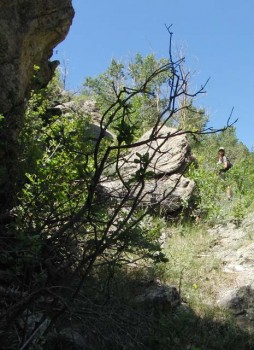
On our way home from Denver last Friday, Gregg and I made a detour up Golden Gate Canyon Road to check out a 93-acre ranch that Marilyn, who I met when she commented on a post, invited us to forage. (Actually, truth be told, I invited myself and she was generous enough to accept.) The canyon is breathtaking and so was her land, 93 acres of very steep hillside accessed by a potentially gnarly dirt road and then slowly through the cattle gate to where her family’s oasis is nestled.
She gave us a quick tour of the property, pointing out all the wild edible plants (even though I though that was my job), and then directed us up the hill. “Make a good hike of it,” she said, sending us on our way.
Well, a “good hike” it certainly was—straight up, up, up, between the rocks, through the scrub, baking in the hot sun—and this after just completing three hours of skate camp in Highlands Ranch, also in the hot sun. So, for the first half of the hike (read: the up part), I was sweating profusely and frustrated with myself for my lack of excitement about the adventure, as I’d looked forward to it the entire week prior. It was all I could do to collect a few edibles while Gregg took photos. “We’ll come back when we’re less tired,” I said, trying to justify my attitude.
But then, near the top of the hill in a ditch right before the well, something wonderful happened that snapped me right out of it: Gregg stuck his hand right into a patch of stinging nettles!
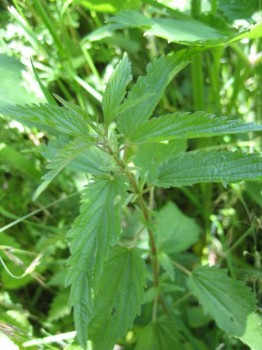
You have to understand. I absolutely love nettles (Urtica dioica), and I’ve only eaten them twice. Ever since I tasted them again on the east coast earlier this summer I’ve been craving them quite possibly more than any other wild edible plant I’ve ever tasted. This is the first time we’ve encountered nettles in Colorado, as they don’t seem to grow at 10,000-11,000 feet where we usually forage.
As Gregg whined and moaned and jumped about, I searched the surroundings for an antidote with which to treat him. No jewelweed there—but after a bit I found some plantain (Plantago, not to be confused with bananas), which is also supposedly good for stings. I crumpled it up and applied it to the boyfriend’s arm, but by that point, however, his pain had subsided, these nettles perhaps less strong than others with which I’ve stung myself.
Then I happily dug out my gloves—which I never bring, by the way; it’s just that we were anticipating cacti—and foraged ¼ plastic grocery bag of nettles, picking the top halves of the youngest plants we could find, since much of it was going to seed already, plus a few mature leaves here and there from farther down the stems. A few days later, back at home, I stripped the leaves off, boiled and served them, later reheating the flavorful cooking water to drink as tea. Seriously, I crave nettles like no other!
Anyway, from that point on, it seemed like nature felt fit to reward our hard hiking work, because suddenly the land seemed full with wild edible plants. We didn’t take a big quantity of anything, as I was mostly intent upon exploring the possibilities, but for those of you foraging near Golden or in a similar habitat here’s a quick tour of what we found, backing down the hill for a minute:
Golden Cow Parsnip
Marilyn pointed out the cow parsnip (Heracleum maximum) in the wooded, steep valley of the drainage near her house, and I was 99% sure of the identification—though even the youngest of the cow parsnip plants seemed to have hairier stems than my Summit County strain, and the plants were not growing thick and lush as they do near here. I took a few leaves and stems and promised her I’d test those on myself and Gregg and report back.
The answer is yes: it is most certainly cow parsnip. We chopped the stems, boiled them with the leaves for 10 minutes, and ate with butter, soy sauce, and finely chopped raw onions like we always do. The Golden cow parsnip was a little farther along than ours, I think—for even the small leaves were pretty strong-tasting—but we liked ‘em anyway.
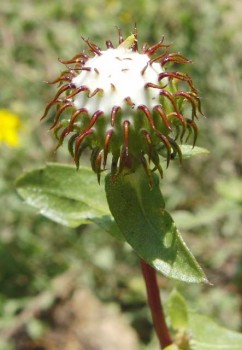
Sticky Gumweed
Sticky gumweed (Grindelia) is another plant Marilyn pointed out on the initial tour. This plant’s unique buds present as cups of white, sticky, sweet-smelling goo. Last year I made medicine out of the flowers and vodka—an expectorant with which I medicated myself over the course of the cold, busy winter. After making my first sticky gumweed concoction, however, I read on Ryan Drum’s website that the medicine in the gumweed’s goo is strongest and perhaps most copious just before the plant flowers, and so this time I collected the sticky buds instead, tried to wash them, chopped, and now have them sitting in a jar of vodka (with the top on, away from the light, jostling occasionally) for a month, at which point I will strain it and shove the liquid medicine into the closet for winter.
Other Finds
While climbing up the hill we took a couple of not-yet-flowering thistle heads from two different species of thistles to try as tiny artichokes, which Samuel Thayer (Forager’s Harvest, 2006) says is possible but not worth the effort, a project I will report on in a subsequent entry. At the top of the hill we gathered big pennycress (Thlaspi arvense) leaves and a bunch of tansy mustard (Descurainia sophia), where they were growing in abundance—and both of which I washed quite well for fear of steer poops, which were everywhere. (Those steer are magnificent, by the way!) Later, the mustard went into tuna salad and a stir fry and the pennycress went into a stir fry too.
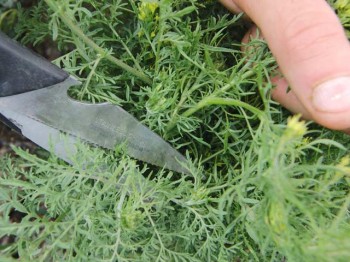
We also nibbled a few early season currants, which should be ripe and abundant all over the hill in short order—though I imagine the ripening will be staggered, perhaps depending on which side of the hill they are growing.
House Weeds
A lot of wild edibles, some of which were once cultivated anyway, grow in greatest abundance in disturbed areas and gardens—in places of human activity, essentially. Whether they respond to the varied soil quality, the added sunlight of a cleared area, or are simply the result of footstep-dropped seeds, there are a number of plants we found to be most plentiful right next to Marilyn’s house—though I was remiss to forage from her flower beds, so to speak, without permission.
She’s such a perceptive and inviting person, though—and so, hours later when we descended the hill, she invited us to do exactly that. I picked giant lamb’s quarters (Chenopodium) from the hill in front of the house where she’d been tossing out her “weeds” before learning of their edibility, and Gregg helped clear some purslane from her garden.
We ate the lamb’s quarters in similar fashion to last year’s Fort Collins harvest—sautéed/steamed, salted, and slightly buttered. They were good, but strong, as I had selected ginormous specimens. Next time I’m going for the slightly younger plants.
Purslane Presents
Purslane is one wild plant that has been coming out of our (ears) these days, since not only Marilyn but also Ruth and Gregg’s step-dad Jim gave us some within days of one another. It seems fitting that just as I publish my second Wild Edible Notebook, featuring purslane (Portulaca oleracea), I should be gifted some of the mucilaginous succulent thrice-over. We polished off the last of the purslane today, I’m pleased to report, and with it the last of the wild edibles we gathered from Golden one week ago.
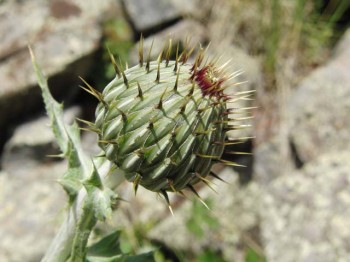
We ate our purslane bounty sauteed with onions and served with sausages; sweet pickled with cabbage and juniper berries; chopped and fried with other veggies and made into fried rice; chopped raw in tuna salad on crackers; and today in one of my favorite purslane recipes—raw tomato and cucumber salad with chopped purslane marinated in homemade French dressing.
A Testament to What You Can Learn
from Books
At the end of the foraging trip, Marilyn asked if we’d found any edible wild plants that she hadn’t already pointed out. I told her about the nettles, which were the only ones, and she seemed disappointed she hadn’t found them herself.
“They must have been at the very top of the hill,” she protested, and it’s true; they were.
Gregg tried to point out other things, but I told him not to bother. “She knows,” I said, for Marilyn had obtained Cattail Bob’s book from interlibrary loan per my suggestion and then proceeded to memorize the entire thing. Encyclopedic and a canner, too—a skill of which I am presently quite envious. I daresay this industrious woman would be well-prepared for any apocalypse-type situation should one happen to occur.

Hey! Doesn’t it always figure…a week later and we have puffball mushrooms in the same draw as the cow parsnips! “Butterpoweredbiker” came up and she gathered a box full of Bee Balm. As we walked to the stream low and behold a very large patch of Nettle! So now I know where it can be found, and most importantly what it looks like!
Enjoyed our visit! Hope to learn more from your site~Marilyn
A large patch of nettles, you say?
Wild foraging is so much fun and so fulfilling, though I must say I have a void in my life for a source of nettle in the front range mountains (not for a lack of looking either!). I was wondering perhaps, if anyone knew of another sweet spot, not that I want to move in on anyone’s stash : ) Or, if Marilyn, you may be open to a young family foraging (and respecting) your chunk of land? Just worth asking, right! Thanks wild food girl for all of your awesome posts!